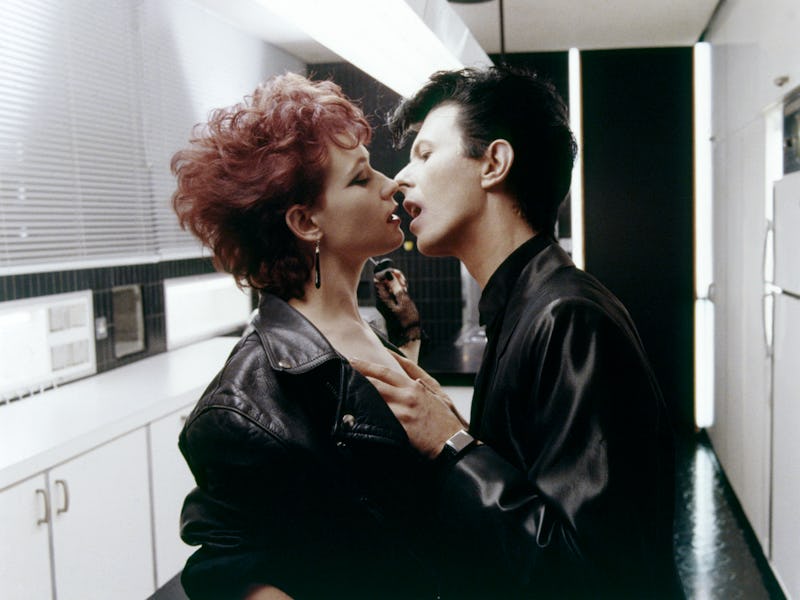David Bowie and Tony Scott Made a Vampire Movie. Somehow, Everyone Forgot About It.
The Hunger isn’t a classic, but its influence is impossible to deny.

Stories that subvert vampire tropes are almost as common as vampire stories themselves. More than any other horror subgenre, vampires are defined by how much they do or don’t fit with the tradition that came before. But in 1983, one underrated movie set a new standard for how contemporary vampires would look and feel. For undying bloodsucker aficionados, David Bowie’s turn in Tony Scott’s The Hunger is worth another look before it leaves HBO Max.
The movie’s first five minutes tell you everything you need to know about it. Although it famously stars Bowie as a vampire named John Blaylock, he’s not the singer who opens the film. Instead, Peter Murphy, the lead singer of Bauhaus, sings the band’s 1979 hit “Bela Lugosi’s Dead.” This, of course, references the actor who made Dracula famous in 1931. Bauhaus singing in a goth club about how old-school vampires are dead is essentially the movie’s message: these aren’t your parents’ vampires! They’re goth bisexuals now, so watch out!
Watching The Hunger today elicits two alternating feelings. You’ll often feel just how innovative and thrilling this movie was for 1983, but you’ll also spend a lot of time thinking about its cinematic and television descendants, many of which are artistically superior or simply more memorable. The plot revolves around a vampire couple, Miriam Blaylock (Catherine Deneuve ) and Blaylock (Bowie), who have been together since the 18th century, a setup that could remind you of Eve (Tilda Swinton) and Adam (Tom Hiddleston) in Only Lover Left Alive or Laszlo (Matt Berry) and Nadja (Natasia Demetriou) in What We Do in the Shadows. The serious setup of the former turned into one of the greatest vampire movies ever, while the latter became a pitch-perfect sitcom.
The Hunger never gets as dramatically compelling as Only Lovers Left Alive, and its camp isn’t quite clever enough to make it as funny as What We Do in the Shadows, but it’s hard to imagine either existing without this movie coming first. In fact, you could also credit the aesthetics of the Blade and Underworld films to The Hunger’s tone and style. Prior to The Hunger, there was a long list of B-movies that walked the line between eroticism and horror, but this feels like a true attempt to make the blend mainstream and pointedly contemporary. This isn’t to say The Hunger is in good taste, but part of its charm is the fact that it isn’t self-consciously drawing attention to its own ridiculousness.
The central conflict revolves around both John and Miriam worrying they’ll lose their vampire mojo, as well as the fact they’re thinking about turning a woman named Sarah (Susan Sarandon) into a vampire too. None of this goes well, because The Hunger is conservative with its plotting. Like most classic vampire stories, the affair has to end in tragedy, even though there are a few twists along the way.
Catherine Deneuve and David Bowie as angsty horndog lovers.
But what’s most remarkable about The Hunger is how it follows vampire traditions in another way: aesthetic reinvention. This brings us back to that opening song, “Bela Lugosi’s Dead.” We tend to think of Bram Stoker’s 1897 Dracula as patient-zero for vampire stories, but that book was a reinvention of less-subtle stories like Varney the Vampire, published way back in 1845. And when Lugosi played Dracula in 1931, that too changed the image of what a vampire was supposed to look like. The Dracula of the novel isn’t dashing or attractive, and neither was the vampire in the 1922 pseudo-adaption, Nosferatu. Part of the immortality of vampires is that what we tend to think of as “classic” is usually a radical reinvention of a previous iteration.
In 1983, The Hunger gave us cool, queer, goth vampires who liked great music, setting up reams of better vampire movies and TV shows to follow. Even if the movie’s legacy is mixed, it mattered. It brought new blood into the genre and, in doing so, maintained a long vampire tradition of constantly being reborn.
The Hunger leaves HBO Max on March 31, 2023.
This article was originally published on